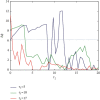Correlation Analysis of Synchronization Type and Degree in Respiratory Neural Network
- PMID: 34987564
- PMCID: PMC8723864
- DOI: 10.1155/2021/4475184
Correlation Analysis of Synchronization Type and Degree in Respiratory Neural Network
Abstract
Pre-Bötzinger complex (PBC) is a necessary condition for the generation of respiratory rhythm. Due to the existence of synaptic gaps, delay plays a key role in the synchronous operation of coupled neurons. In this study, the relationship between synchronization and correlation degree is established for the first time by using ISI bifurcation and correlation coefficient, and the relationship between synchronization and correlation degree is discussed under the conditions of no delay, symmetric delay, and asymmetric delay. The results show that the phase synchronization of two coupling PBCs is closely related to the weak correlation, that is, the weak phase synchronization may occur under the condition of incomplete synchronization. Moreover, the time delay and coupling strength are controlled in the modified PBC network model, which not only reveals the law of PBC firing transition but also reveals the complex synchronization behavior in the coupled chaotic neurons. Especially, when the two coupled neurons are nonidentical, the complete synchronization will disappear. These results fully reveal the dynamic behavior of the PBC neural system, which is helpful to explore the signal transmission and coding of PBC neurons and provide theoretical value for further understanding respiratory rhythm.
Copyright © 2021 Jieqiong Xu et al.
Conflict of interest statement
The authors declare that they have no conflicts of interest.
Figures


















Similar articles
-
The role of individual neuron ion conductances in the synchronization processes of neuron networks.Neural Netw. 2021 May;137:97-105. doi: 10.1016/j.neunet.2021.01.019. Epub 2021 Jan 29. Neural Netw. 2021. PMID: 33578080
-
Time delay induced different synchronization patterns in repulsively coupled chaotic oscillators.Chaos. 2013 Sep;23(3):033140. doi: 10.1063/1.4821942. Chaos. 2013. PMID: 24089976
-
Energy dependence of synchronization mode transitions in the delay-coupled FitzHugh-Nagumo system driven by chaotic activity.Cogn Neurodyn. 2024 Apr;18(2):685-700. doi: 10.1007/s11571-023-10021-9. Epub 2023 Nov 2. Cogn Neurodyn. 2024. PMID: 39584051 Free PMC article.
-
Models of respiratory rhythm generation in the pre-Bötzinger complex. II. Populations Of coupled pacemaker neurons.J Neurophysiol. 1999 Jul;82(1):398-415. doi: 10.1152/jn.1999.82.1.398. J Neurophysiol. 1999. PMID: 10400967
-
Phase response approaches to neural activity models with distributed delay.Biol Cybern. 2022 Apr;116(2):191-203. doi: 10.1007/s00422-021-00910-9. Epub 2021 Dec 2. Biol Cybern. 2022. PMID: 34853889 Review.
Cited by
-
Lag Synchronization of Noisy and Nonnoisy Multiple Neurobiological Coupled FitzHugh-Nagumo Networks with and without Delayed Coupling.Comput Intell Neurosci. 2022 Jun 2;2022:5644875. doi: 10.1155/2022/5644875. eCollection 2022. Comput Intell Neurosci. 2022. PMID: 35694576 Free PMC article.
References
MeSH terms
LinkOut - more resources
Full Text Sources

